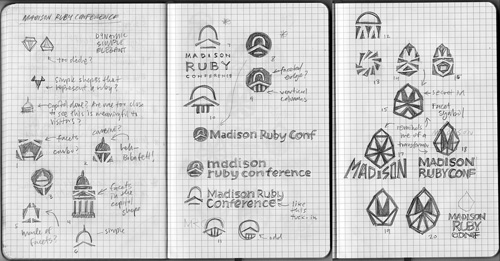The Process of Creativity
The creative attribute has always been a highly debated and researched component of the human psyche. The “designer” job title seems to be one that calls to the more creative minded among us and according to some, requires the highest level of creative processing. This idea does lend itself to the truth, web designers are called upon to find creative solutions every day. However, we certainly aren’t alone.
Contrary to previous belief, creativity does not limit itself to the “right-brained” artistic types. The ability to find creative and innovative solutions to problems holds value in almost all aspects of life.
Further Reading on SmashingMag:
- Is The Internet Killing Creativity?
- Learning More About Creativity From LEGO
- How Working Walls Unlock Creative Insight
- How To Transform Your Problem-Solving And Creativity
Even those with highly analytical jobs and hobbies benefit from the ability to approach a complex issue from different perspectives and foresee alternate outcomes. So perhaps it shouldn’t come as much of a surprise to suggest that creativity itself is more rooted in a process than random visionary moments.

In one way or another we have all experienced that classic “aha” moment. Be it in our own experience or through those genius minds we love to follow in shows, movies or books, the light bulb moment of mental clarity is an iconic expression. But whether you know it or not you may be reaching those light bulb moments through more of a defined process than you think.
The Not-So-Random Spark
Believe it or not, you have probably been practicing the process of creative thinking on purpose for quite a while. Have you ever been instructed to skip a question on an exam that has you stumped and come back to it after you’ve answered the others? Or maybe it’s been something as simple as facing a tough choice with the decision to “sleep on it”. This might seem to imply that our brains continue to work on our hardest problems for us while we sleep or think about something else. Unfortunately it’s not quite that easy.
Even if by accident, when you let go of a problem that you can’t solve you are actively engaging in mental incubation. As it turns out, leaving a complex issue to its own devices doesn’t generate a resolution out of passive thought processes so much as an active new approach. This different approach allows our minds to set aside failed solutions and misconceptions that we generated on our first pass. We aren’t suddenly finding a new solution so much as we are allowing ourselves to shed our fixation on all of the things we thought of before that didn’t work.
As we move on with our day or the next task, those bits of information that we forget may be replaced with different pieces to the puzzle. These pieces are pulled from other tasks or mental processes and applied to the equation we couldn’t solve earlier. When something from a current and not necessarily related task locks in with the problem we couldn’t figure out earlier the light switch flips on.

For designers we should be able to put this into context fairly easily. Certainly there are those among us who have been plagued with the eternal judgment of the typography, layout, and color choices that we see around us everywhere. Even the task of e-mail a client back and explaining why we shouldn’t make their logo bigger sparks thoughts of alignment, positioning and weight. In processing the things that we do or don’t like we constantly build our mental database of micro-ideas that we apply to our designs.
This seems a little less fun than random strokes of genius but it does give us the power to craft our own epiphanies instead of letting them fall upon us. It is because of this, that a lot of designers find success moving between tasks on a single project or shifting to an entirely new project when they feel their creative juices waning.
At the head of all of this it is important to remember that a lot of designers depend on their skill set to make a living. So trying to implement time to let your mind rest doesn’t coincide well with meeting deadlines and “thinking time” doesn’t look great on a project invoice. Like so many things, practice makes perfect in this area and you can go ahead and plan on getting it wrong the first time around. As you become more comfortable with your own working and thinking pace it will allow you to better predict the timeline of a project that includes the mental brakes you need to find creative answers.
Practicing Creativity
For some it may be a little disappointing to think that all of those inspirational moments that came over breakfast, in the shower or on the morning commute were a little more scripted than we thought. On the other side of that coin though lies the potential to place a little more control over our inspirations. Could it be possible that the answer to being a creative individual lies within a process that we can all replicate on demand?

Well, of course there is not worksheet to follow along with that can promise unlimited creative power. We all have different capacities for intelligence, imagination and creativity so naturally some will have higher creative thresholds than others. With that said, there are a lot of theories out there about the various thought processes that spark creativity and how they can be harnessed.
Distance Makes the Design Grow Fonder
One of my favorite methods for finding that inner creativity is the process of disassociation. This type of thinking can come in quite a few forms but always has the same core component. The point of disassociating your thoughts is always to force your brain to take a new perspective on a problem.
One way of doing this is through purging thoughts. In a previous article on Abduzeedo, covering some additional thoughts on the creative process, they discuss an experience with a former professor. The task was to sketch out a logo for a new project but the challenge was the 150 required variations of the logo. The point here is that so many of our initial thoughts and ideas are based on our previous experience or observations. We can’t expect to provide a unique design until we have purged our minds of ideas that were gathered from other sources. Many designers will admit to having sketch books full of logo or design variations that range from tiny detail changes to entirely new concepts, all of which is part of the process of coming up with creative ideas.

Two Heads are Always Better
Another interesting technique that plays along with the rules of disassociation is the process of making decisions for someone else. In a fun trick of the brain, it turns out that we may very likely be better at making more creative decisions for other people than we are for ourselves. Cashing in on this theory could take us down several paths.
First, this places emphasis on the importance of feedback. Anyone who has been waist deep in a project for an extended period of time has likely had the experience of being too familiar with the work. A jaded designer can easily miss key components of a design. Other designers who are familiar with the task and goal but not the exact job at hand are a great resource for situations like these. But what about those unfortunate times when another designer isn’t handy?
An admittedly more difficult but still productive option is to treat your own design as though it belongs to someone else. If you find yourself stuck on a project, try splashing a little bit of that incubation process we talked about earlier on it and re-approach the project as though you’re helping a peer review their design. Forget about what work might be involved behind your suggestions or any pre-conceived notions of how other project stakeholders might respond to your suggestions. Finding points where you manage to disagree with yourself is a good clue that this process working.

Creativity is not Magic
At the end of the day are some people more creative than others? Yes. But are there people that simply lack the ability to be creative at all? I don’t believe so. We all have tasks that require a little bit of creativity to complete, for some of us it may be the process of a logo or web design yet for others it could be finding a more efficient formula or algorithm. Heck, depending on where you live it might require some creativity to find a parking spot at home after 5:00pm.
As something that is a part of all of us, I don’t find creativity to be any kind of magical power. This is just as well, because it means we can practice creative thinking and encourage the process when we need it the most. Methods such as mental incubation, disassociation, and forced third party perspective may not yield the best solutions for everyone but the topic of creative thinking is a broad one that includes dozens of different theories. If you are someone who draws on your creativity on a regular basis I would encourage you to take some time and find out what works best for you.
In presenting the topic of creativity to a group of creative people I would fully expect that some of you have perspectives on these thoughts that are well… creative. Do you have a process that you take that seems to lead you to a light bulb moment? Do these moments strike you as pure chance or a scheduled epiphany? Let us know what inspires the most creativity out of you!
Additional Resources
- Dynamic Memory Processes in Retrieving Answers to Questions, I Yaniv, D E Meyer, N S Davidson Dig into pages 81 through 90 in this article for an in depth look at the theories behind mental incubation.
- The Nature of Insight, Robert Sternberg This book digs into exercising our creative thought processes and examines how we can capture insightful thinking processes.
- How We Decide, Jonah Lehrer A great resource for designers, Jonah’s book is a classic work that encourages readers to think about how we think.


 SurveyJS: White-Label Survey Solution for Your JS App
SurveyJS: White-Label Survey Solution for Your JS App


 Agent Ready is the new Headless
Agent Ready is the new Headless


